Most Lincoln Memorial cents are common and inexpensive, but the 1976 penny can carry higher value in rare conditions. This year holds a unique place in American coinage history, as it marked the bicentennial—200 years since the signing of the Declaration of Independence.
While the Lincoln cent didn’t feature the special dual-date (1776–1976) like other denominations, the surge of patriotic interest led collectors to value coins from this year more, and some 1976 pennies have sold for hundreds or even thousands at auction depending on their rarity and grade.
1976 Penny Value Chart
| Condition | 1976 (No Mint Mark) | 1976-D | 1976-S (Proof) |
|---|---|---|---|
| MS 65 | $14 | $26 | / |
| PR 65 | / | / | $7 |
History of the 1976 Penny

The 1976 Lincoln pennies belong to the Memorial cent series, originally issued to mark the 150th anniversary of Abraham Lincoln’s birth. While the first Lincoln cents debuted in 1909 with wheat ears on the reverse, a major design shift occurred in 1959, when the Lincoln Memorial replaced the wheat design to celebrate another milestone—Lincoln’s 150th birthday.
The Lincoln Memorial design remained in use through 2008.
Interestingly, 1976 was not only a tribute to Lincoln but also a historic year for America, as it marked the 200th anniversary of the Declaration of Independence signed on July 4, 1776. While the Bicentennial coins (such as the Eisenhower dollar, Kennedy half dollar, and Washington quarter) featured a special dual date (1776–1976), the penny did not. Instead, it carried only the single-year date like other regular cents.
1976 Penny Mintage by Type
| Location | Coin Type | Mintage |
|---|---|---|
| San Francisco | 1976-S Proof Penny | 4,149,730 |
| Philadelphia | 1976 No Mint Mark Penny | 4,674,292,426 |
| Denver | 1976-D Penny | 4,221,592,455 |
| Total Mintage | 8,900,034,611 |
Fun Fact:
The West Point Mint also produced Lincoln pennies in 1976, as it did from 1974 to 1986, but they lacked a mint mark, just like the Philadelphia coins. That makes it impossible to distinguish West Point cents from their Philadelphia counterparts.
Features of the 1976 Penny
The obverse of the 1976 penny
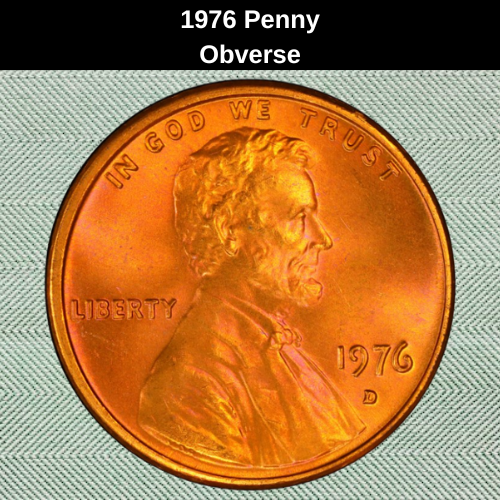
The obverse of the 1976 Lincoln penny features a right-facing bust of President Abraham Lincoln at its center. Just in front of Lincoln’s profile, you’ll find the minting year “1976” along with the mint mark (if present).
Behind Lincoln’s shoulder, the word “LIBERTY” is inscribed, while the national motto “IN GOD WE TRUST” arches above his head—a standard element on all U.S. coins.
At the truncation of the bust, near Lincoln’s shoulder, you’ll spot the tiny initials “VDB,” which stand for Victor David Brenner, the designer of the original Lincoln cent introduced in 1909.
The reverse of the 1976 penny/cent
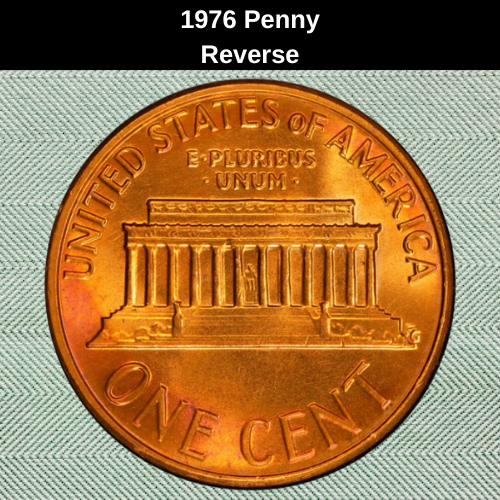
The reverse of the 1976 Lincoln penny was designed by Frank Gasparro and was used from 1959 to 2008. The central feature is the Lincoln Memorial, with Gasparro’s initials, “FG,” visible to the right of the monument.
The structure displays twelve front-facing pillars, and between the 6th and 7th pillars, you can spot a tiny depiction of the seated Lincoln statue—a nod to the actual memorial in Washington, D.C.
The coin’s denomination “ONE CENT” is positioned at the bottom, while the legend “UNITED STATES OF AMERICA” curves along the top rim. Just above the building, the motto “E • PLURIBUS • UNUM” is centered in small capital letters.
1976 Penny Details
- Face Value: $0.01 (One Cent)
- Composition: Gilding metal (95% copper, with 5% zinc or tin)
- Thickness: 0.06 inches (1.52 mm)
- Shape: Round
- Diameter: 0.75 inches (19.05 mm)
- Weight: 0.11 ounces (3.11 g)
- Edge: Plain (smooth, no reeds)
Other Features of the 1976 Penny
Like all Lincoln Memorial cents minted from 1962 to September 1982, the 1976 penny has a standard weight of 48 grains, which equals 0.11 ounces or 3.11 grams. These round coins are made from gilding metal, an alloy composed of 95% copper and 5% zinc or tin. Each piece measures 0.75 inches (19.05 mm) in diameter and is 0.06 inches (1.52 mm) thick.
1976 Penny/Cent Grading
While many collectors prefer professionally graded coins, this may not be practical for lower-value coins like the 1976 penny. In such cases, you can estimate your coin’s condition using the Sheldon Grading Scale, a widely accepted method among numismatists. By comparing your coin to clear grading descriptions, you can determine its approximate grade and value.
Here’s a simplified version of the Sheldon scale for reference:
| Grade Number | Grade Name |
|---|---|
| 1 | Basal State-1 |
| 2 | Fair |
| 3 | Very Fair |
| 4, 5, 6 | Good |
| 7, 8, 10 | Very Good |
| 12, 15 | Fine |
| 20, 30 | Very Fine |
| 40 | Extremely Fine |
| 50 | About Uncirculated |
| 60 | Mint State (MS 60) |
| 65 | Mint State (MS 65) |
| 70 | Mint State (MS 70) |
Tip: Use our grading guides to accurately compare your coin and determine its market value.
1976 Penny Value Guides
In 1976, the total mintage for No Mint Mark pennies reached an impressive 8,900,034,611 coins. The vast majority of these were regular circulation strikes, while the San Francisco Mint produced only proof coins, exclusively made for collectors.
Despite this seemingly massive production, 1976 pennies are still commonly found in circulation, which limits their rarity and, consequently, their market value. For this reason, only coins in exceptional condition or with unique errors tend to fetch higher prices among collectors.
1976 No Mint Mark penny Value
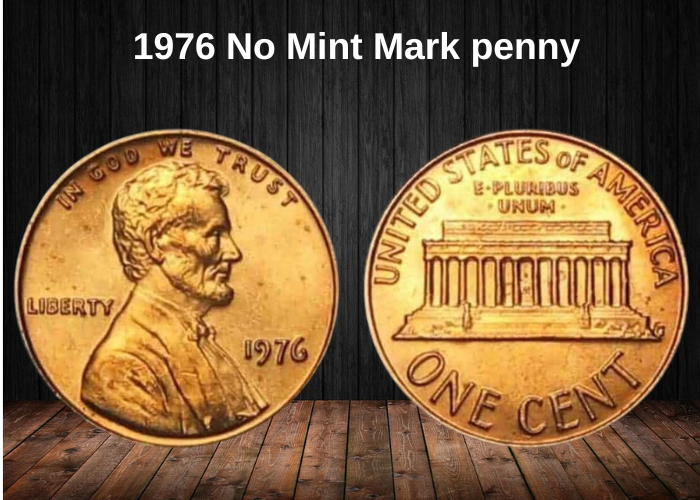
The Philadelphia Mint had the highest output of 1976 pennies, releasing a massive 4,674,292,426 coins into circulation during that bicentennial year. Many of these coins are still in circulation today, making worn or circulated examples essentially non-collectible.
Even mint-state red-toned specimens typically sell for less than $1, unless they reach particularly high grades.
- MS 66 red cents are valued at around $26.
- MS 67 red examples can reach $100, though even a red-brown MS 67 sold for $123 at auction in 2020.
- In 2022, a rare brown MS 69 specimen fetched $295.
- The most valuable 1976 Philadelphia penny to date is a red MS 68, which sold for a remarkable $7,931 at auction in 2014.
1976 S proof penny Value
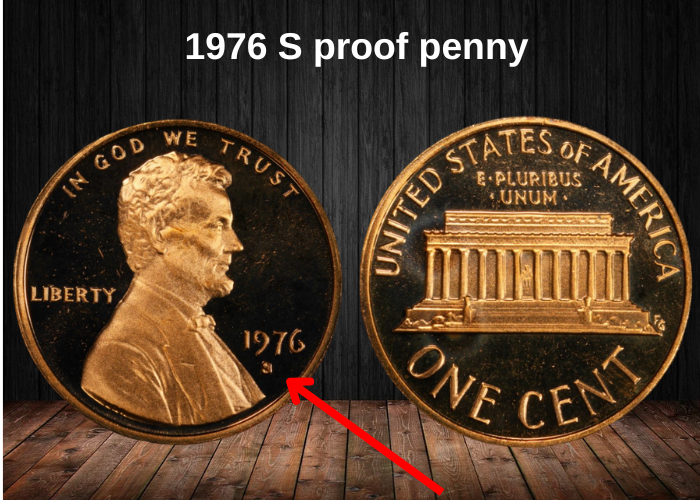
In 1976, the San Francisco Mint exclusively produced proof pennies, with a total mintage of 4,149,730 pieces. These coins were struck for collectors and are known for their high-quality finish, especially the Deep Cameo (DCAM) varieties.
The value of these red DCAM proofs depends largely on their condition. Most coins graded between PR 60 and PR 64 are quite common and generally cost less than $0.25.
Here are typical prices for higher-grade examples:
- $7 for PR 65
- $8 for PR 66
- $10 for PR 67
- $24 for PR 68
- $36 for PR 69
As is often the case, auction prices can be significantly higher:
- The highest price for a regular red coin was $207.
- The most expensive 1976-S proof penny was a DCAM specimen, which sold for a staggering $1,208 at auction in 2002.
1976 D penny Value
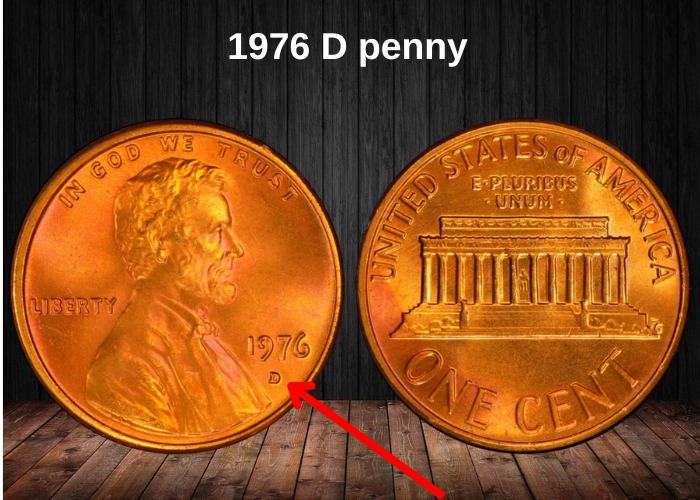
Most of the 4,221,592,455 pennies minted in Denver in 1976 are considered common and hold little value for collectors in circulated condition. However, those in uncirculated condition can be more desirable, especially as part of a complete set.
- Red pennies in lower mint state grades (MS 60 to MS 65) typically sell for $0.20 to $1.
- Coins graded MS 66 can be worth around $55.
- The most valuable are the MS 67 red cents, which can reach $500.
Interestingly, some brown cents can outperform red ones at auction:
- A brown 1976-D penny in MS 60 sold for $1,265 at auction in 2007.
- By contrast, a red MS 67 penny from 1976-D fetched only $999 at a 2016 auction—a rare case where a brown coin outsold a higher-grade red.
Rare 1976 Penny/Cent Errors List
Off-center
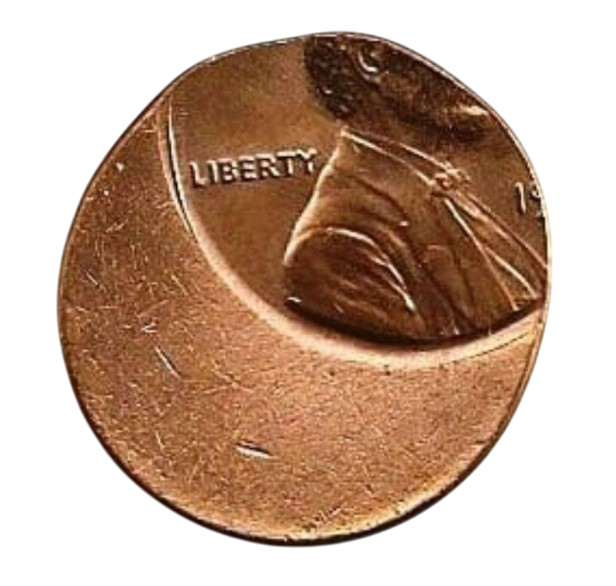
1976 Penny Off-Center and Die Break Errors
When the penny planchet shifts during the first die strike, the result is a partially blank coin known as an off-center error.
- A 1976 penny with a 50% off-center strike and a visible date typically sells for $50 to $110.
- Minor errors with only 5% to 10% off-center are generally worth up to $10.
- A penny with a 60% off-center error usually sells for around $60.
- Although 80% off-center pennies are often considered worthless, rare pieces with a visible date can sell for $185 to $230.
Die Break (Cud) on Obverse
When an old or damaged die is used, it can leave noticeable marks on the coin surface. These are known as die breaks or cuds.
- A 1976 penny with a die break on the obverse can be worth around $100.
Penny struck on a 5c (clad nickel) planchet
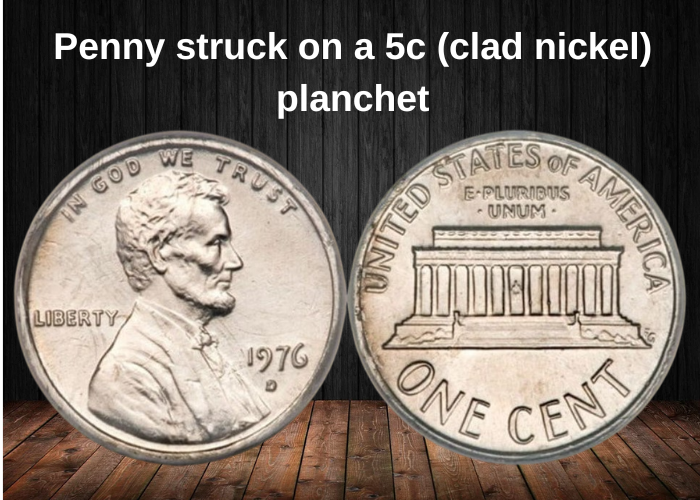
A rare 1976 penny minted in Denver was accidentally struck on a nickel planchet, making it a highly desirable mint error valued at over $1,200.
- Unlike regular pennies that measure 0.75 inches (19.05 mm) in diameter, the nickel planchet used here is 0.835 inches (21.21 mm) wide.
- The color is noticeably different because it was made from cupronickel, not the typical 95% copper alloy used for pennies minted up until 1982.
Penny Struck on a Dime Planchet
Another recognized mint error is a penny struck on a dime (10¢) planchet.
- These coins are smaller, with a diameter of 0.705 inches (17.91 mm)—not 7.50 inches (19.05 cm) (that looks like a typo; standard penny size is 0.75 inches, not 7.5 inches).
- Dime planchets are made from nickel-plated cupronickel, are 0.053 inches (1.35 mm) thick, and feature a reeded edge, unlike the plain edge on pennies.
- The result is a silver-colored penny with parts of the design often missing due to the smaller planchet size.
1976-D Penny Struck on a Thin Planchet
In 1976, the Denver Mint accidentally struck some pennies on planchets that were too thin, leading to:
- Incorrect weight or diameter
- For example, one such penny weighed only 0.0596 ounces (1.69 g), compared to the standard 0.1097 ounces (3.11 g)
- These error coins are valued at around $25
Doubled Die Error
A doubled die occurs when a die with a doubled design strikes the planchet, resulting in:
- Visible doubling on parts of the coin (typically the date or lettering)
- 1976 examples are known, but most show only minor imperfections
- Depending on the degree of doubling and overall condition, values range from $25 to $100
BIE Error
This popular die break error features a raised “I” between the “B” and “E” in the word LIBERTY, resembling the word “BIE.”
- These errors are well-known and collectible
- A 1976 penny with this error is typically worth $5 to $15
RPM (Repunched Mint Mark) Error
Before 1990, mint marks were hand-punched, sometimes requiring a second punch to correct misalignment.
- A 1976-D penny may show a second D underneath the correctly placed mint mark
- These RPM errors generally sell for $10 to $12
Double-Struck Error
If the coin is struck twice by the die but shifts position between strikes, it produces a double-struck (DBL) error.
- This often results in an irregular or extended part of the design, with parts of the second strike hanging off the edge
- Such dramatic error coins are valued around $145
Where to sell your penny?
Now that you know the value of your penny, you might be wondering where to sell it. Don’t worry: here’s a guide to some of the best online platforms where you can easily sell your coins, along with their advantages and disadvantages.
Discover the best platforms for selling coins online (pros and cons).
1976 Lincoln Penny FAQ
1. Is the 1976 Lincoln Penny rare or valuable?
No, the 1976 penny is not rare. It was minted in very large quantities, and most are only worth face value (1 cent) in circulated condition. However, uncirculated examples in MS65+ condition, especially with full red color, can be worth $1 to $10, or more for higher grades.
2. What mint marks were used on 1976 Lincoln cents and how do they affect value?
- No mint mark (Philadelphia): ~4.6 billion minted
- D (Denver): ~4.2 billion minted
- S (San Francisco – proof only): ~4 million minted
The mint mark is on the obverse (front) of the coin, just below the date. While mint mark doesn’t significantly change value for most coins, proof coins from San Francisco are more collectible and can be worth $2 to $15, especially in PR67 or higher with Deep Cameo finish.
3. Are there any known errors or varieties for the 1976 penny?
Yes, but none are famous or extremely rare. Collectors sometimes find:
- Repunched Mint Marks (RPMs) on Denver coins
- Die cracks or die breaks (also called cuds)
- Off-center strikes
- Clipped planchets
- Subtle double dies (less prominent than 1972 DDO)
These can increase the coin’s value depending on visibility and rarity—ranging from $10 to several hundred dollars for more dramatic errors.
4. What is the metal composition of the 1976 penny?
The 1976 penny is made of 95% copper and 5% tin and zinc. This composition was used until 1982. Each 1976 penny weighs 3.11 grams, which can be used to distinguish it from post-1982 zinc coins.
💡 Fun Fact: Due to high copper prices, the melt value of a 1976 penny can be over 2 cents—but melting pennies for metal is illegal in the U.S.
5. What is the significance of the design on the 1976 penny?
- Obverse: Features Abraham Lincoln, designed by Victor David Brenner.
- Reverse: Depicts the Lincoln Memorial, designed by Frank Gasparro.
There were no special bicentennial penny designs in 1976. Only the quarter, half dollar, and dollar coins had bicentennial reverse designs.
6. How much is a 1976 Lincoln penny worth in uncirculated condition or as a proof?
- Uncirculated MS65 Red: $2–$5
- MS67 Red: Can fetch $50+ depending on demand
- Proof 1976-S: $2–$15 depending on PR grade and cameo contrast
Grading, eye appeal, and color designation (Red, Red-Brown, or Brown) greatly affect value.
7. How can I tell if I have a valuable 1976 penny?
To identify value:
- Inspect the coin under magnification for RPMs, doubling, or errors.
- Check the luster and condition — full red, mint-state coins are worth more.
- Weigh the coin to ensure it’s copper (3.11g) and not a post-1982 zinc planchet (2.5g).
- Consider professional grading for pristine coins with potential value.


















































